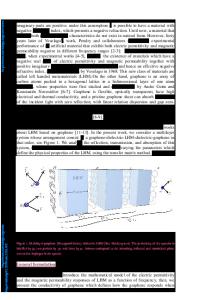Dielectric and Optical Properties of Perovskite-type Artificial Superlattices
- PDF / 505,040 Bytes
- 6 Pages / 612 x 792 pts (letter) Page_size
- 53 Downloads / 441 Views
G5.3.1
Dielectric and Optical Properties of Perovskite-type Artificial Superlattices Takakiyo Harigai, Song-Min Nam, Hirofumi Kakemoto, Satoshi Wada, Keisuke Saito1 and Takaaki Tsurumi Department of Metallurgy and Ceramics Science, Graduate School of Science and Engineering, Tokyo Institute of Technology, 2-12-1 Ookayama, Meguro-ku, Tokyo 152-8552, Japan 1 BRUKER AXS K. K., 3-9-A Moriya-cho, Kanagawa-ku, Yokohama-shi, Kanagawa 221-0022, Japan ABSTRACT BaTiO3/SrTiO3, BaTiO3/BaZrO3, and SrZrO3/SrTiO3 artificial superlattices were fabricated on SrTiO3 substrates by the molecular beam epitaxy (MBE) process. The stacking periodicity of each layer was varied from 1 unit cell to 40 unit cells, and the total thickness was fixed at 80 unit cells. In-situ reflection high-energy electron diffraction (RHEED) and x-ray diffraction (XRD) clearly shows the formation of the superlattice structure. Their lattice parameters obtained from the reciprocal space mapping measurement indicated that the lattice distortion was dependent on the stacking periodicity. The capacitance and the complex admittance of the superlattices were measured with interdigital electrodes by an impedance analyzer up to 110 MHz. It was found that the dielectric permittivity changed with the superlattice periodicity. The Q-V measurement results showed clear hysteresis curves and this suggested that ferroelectricity was induced into the SrZrO3/SrTiO3 superlattices despite a combination between paraelectrics/paraelectrics. INTRODUCTION Artificial superlattices of oxide materials are of interest in numerous applications as new electronic devices because the superlattices have the potential to drastically improve material properties or to show unknown functionality. And the bulk materials with the perovskite-type structure exhibit various physical properties, such as ferroelectricity, superconductivity and so on. Therefore, the perovskite-type solid-solution thin films have been intensively investigated in the oxide materials. Artificial superlattices which laminated the perovskite-type materials of the different characteristics at an atomic level are expected that it is one of the most interesting systems in research of the oxide superlattices. Some researches1-4 concerning BaTiO3(BTO)/SrTiO3(STO) system have succeeded in fabricating artificial superlattices, and their superlattices show different behaviors from solid solutions of BTO and STO. In the our previous studies5,6, dielectric properties of several kinds of BTO/STO superlattices were measured. As a result, it was clarified that the in-plane dielectric permittivity of BTO/STO superlattices depended on the stacking period of superlattices. The superlattices with the periodicity of 10 unit cells (call 10-periodic structures hereafter) showed a maximum permittivity above 30,000, which was almost independent from frequency up to 110 MHz. The refractive index of superlattices measured with a spectroscopic ellipsometer also showed the highest value in the superlattice consists of the 10-periodic structures. This
Data Loading...









